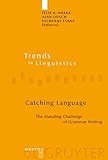Catching Language : The Standing Challenge of Grammar Writing / ed. by Alan Dench, Felix K. Ameka, Nicholas Evans.
Material type: TextSeries: Trends in Linguistics. Studies and Monographs [TiLSM] ; 167Publisher: Berlin ; Boston : De Gruyter Mouton, [2008]Copyright date: ©2006Description: 1 online resource (662 p.)Content type:
TextSeries: Trends in Linguistics. Studies and Monographs [TiLSM] ; 167Publisher: Berlin ; Boston : De Gruyter Mouton, [2008]Copyright date: ©2006Description: 1 online resource (662 p.)Content type: - 9783110186031
- 9783110197693
- 808/.066418 22
- P53.412 .C38 2006eb
- online - DeGruyter
- Issued also in print.
| Item type | Current library | Call number | URL | Status | Notes | Barcode | |
|---|---|---|---|---|---|---|---|
 eBook
eBook
|
Biblioteca "Angelicum" Pont. Univ. S.Tommaso d'Aquino Nuvola online | online - DeGruyter (Browse shelf(Opens below)) | Online access | Not for loan (Accesso limitato) | Accesso per gli utenti autorizzati / Access for authorized users | (dgr)9783110197693 |
Frontmatter -- Contents -- Introduction: Catching language -- Grammaticography: The art and craft of writing -- grammars -- Real descriptions: Reflections on native speaker -- and non-native speaker descriptions of a language -- Realizing Humboldt’s dream: Cross-linguistic -- grammatography as data-base creation -- The organization of reference grammars: A -- typologist user’s point of view -- Calculus of possibilities as a technique in -- linguistic typology -- Descriptive theories, explanatory theories, and -- Basic Linguistic Theory -- Let the language tell its story? The role of -- linguistic theory in writing grammars -- On describing word order -- Heterosemy and the grammar-lexicon -- trade-off -- Field semantics and grammar-writing: Stimulibased -- techniques and the study of locative verbs -- Taking a closer look at function verbs: Lexicon, -- grammar, or both? -- Converbs in an African perspective -- From Eurocentrism to Sinocentrism: The case of -- disposal constructions in Sinitic languages -- How to miss a paradigm or two: Multifunctional ma- -- in Tagalog -- The interplay of synchronic and diachronic -- discovery in Siouan grammar-writing -- The historical and cultural dimensions in grammar -- formation: The case of Modern Greek -- Polylectal grammar and Royal Thai -- Writing culture in grammar in the Americanist -- tradition -- Backmatter
restricted access online access with authorization star
http://purl.org/coar/access_right/c_16ec
Descriptive grammars are our main vehicle for documenting and analysing the linguistic structure of the world's 6,000 languages. They bring together, in one place, a coherent treatment of how the whole language works, and therefore form the primary source of information on a given language, consulted by a wide range of users: areal specialists, typologists, theoreticians of any part of language (syntax, morphology, phonology, historical linguistics etc.), and members of the speech communities concerned. The writing of a descriptive grammar is a major intellectual challenge, that calls on the grammarian to balance a respect for the language's distinctive genius with an awareness of how other languages work, to combine rigour with readability, to depict structural regularities while respecting a corpus of real material, and to represent something of the native speaker's competence while recognising the variation inherent in any speech community. Despite a recent surge of awareness of the need to document little-known languages, there is no book that focusses on the manifold issues that face the author of a descriptive grammar. This volume brings together contributors who approach the problem from a range of angles. Most have written descriptive grammars themselves, but others represent different types of reader. Among the topics they address are: overall issues of grammar design, the complementary roles of outsider and native speaker grammarians, the balance between grammar and lexicon, cross-linguistic comparability, the role of explanation in grammatical description, the interplay of theory and a range of fieldwork methods in language description, the challenges of describing languages in their cultural and historical context, and the tensions between linguistic particularity, established practice of particular schools of linguistic description and the need for a universally commensurable analytic framework. This book will renew the field of grammaticography, addressing a multiple readership of descriptive linguists, typologists, and formal linguists, by bringing together a range of distinguished practitioners from around the world to address these questions.
Issued also in print.
Mode of access: Internet via World Wide Web.
In English.
Description based on online resource; title from PDF title page (publisher's Web site, viewed 28. Feb 2023)


